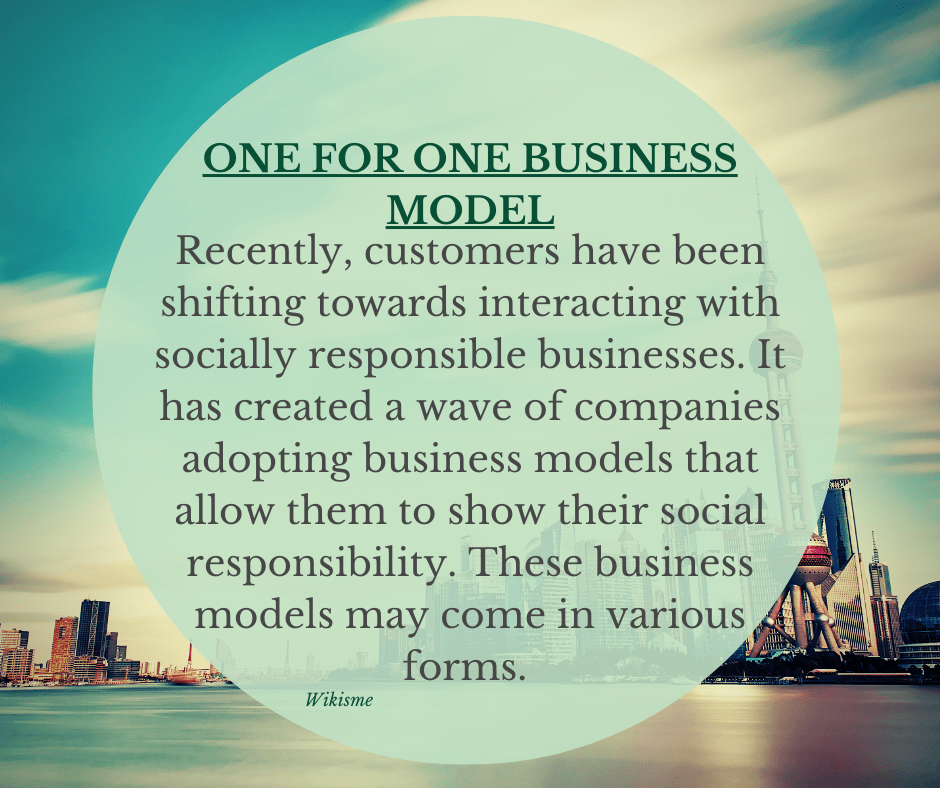Recently, customers have been shifting towards interacting with socially responsible businesses. It has created a wave of companies adopting business models that allow them to show their social responsibility.
These business models may come in various forms. One such popular business model that some companies have adopted is the One for One business model.
What is the One for One business model?
The one-for-one business model comes from TOMS shoes, founded by Blake Mycoskie in 2006. While not highly profitable, the business model is one of the most well-known business models for socially responsible companies.
Many other companies worldwide have started adopting the same business model or a variant.
With the one-for-one business model, a company that believes in social entrepreneurship gives away one product for each item its customers purchase.
For example, a company that sells shoes gives away a pair of shoes for each pair sold to its customers. Usually, the company also chooses to whom it wants to donate the products.
There is still debate about how profitable this business model is. It is mainly because a company relinquishes half its earnings in favor of social entrepreneurship.
However, companies using the model are highly appreciable by customers who believe in socially responsible businesses.
How does the One for One business model work?
The way the one-for-one business model works is simple. A company that uses this model sells its products in a normal way. After some time, it evaluates how much sales it has made.
After determining the amount, it donates the same number of products sold to a social group that needs it. Usually, companies distribute their products to developing countries or disadvantaged social groups free of charge.
For example, a company sells shirts and uses the one-for-one business model. The company sells 2 million shirts in a year. Then the company gives away the same number of shirts, 2 million, to various social groups, usually in developing or emerging countries.
The company does not profit from the giveaway of its products to the group.
While the company may not profit from its giveaways, it may still profit from its products sold to regular customers. The one-for-one business model allows companies to create a unique identity among customers.
Due to the market saturation by larger companies, customers find it difficult to differentiate between competing brands. That is where this business model helps them.
What are the advantages and disadvantages of the One for One business model?
There are only a few companies that have adopted the one-for-one business model. For those companies, the business model brings a few advantages and disadvantages. Some of these include the following.
Advantages
The one-for-one business model helps companies attract customers that believe in socially responsible businesses. This group of customers is difficult to charm for companies.
Therefore, by adopting a one-for-one business model, companies can increase their sales and boost their reputation. It also increases the customer loyalty that companies experience.
The one-for-one business model can also greatly attract investors and other donations. Customers and investors look for companies that believe in social entrepreneurship.
Through this, companies can expand their business and fund their activities.
The one-for-one business model also has lower entry barriers than other business models.
It provides a ground for companies to promote themselves or their daily activities. For some companies, the business model can be a great way to put themselves on the map.
Disadvantages
While the one-for-one business model promotes social change, some experts believe it doesn’t do much in fighting poverty or bringing change.
By giving away their products, companies can’t achieve great development.
These experts believe if the companies invested in developing countries instead of giving away products, it would result in a better chance.
The business model also creates an unlevel business environment for companies that don’t have the resources to compete with others in the market.
Larger companies can use this business model to their advantage when they know that their competitors can’t use the same strategy.
Examples
The primary example of a company using the one-for-one business model is TOMS Shoes, also its creator. TOMS Shoes gives away a pair of shoes to a developing country for every pair it sells.
Other companies that have followed in the same footsteps include Warby Parker, Two Degrees Food, etc. These companies also believe in social entrepreneurship and carry out similar activities.
Conclusion
The one-for-one business model is for companies that believe in social entrepreneurship. These companies give away one product to the needy social groups for every product they sell to their customers.
While the business model is great for companies in several ways, it also has some disadvantages.

